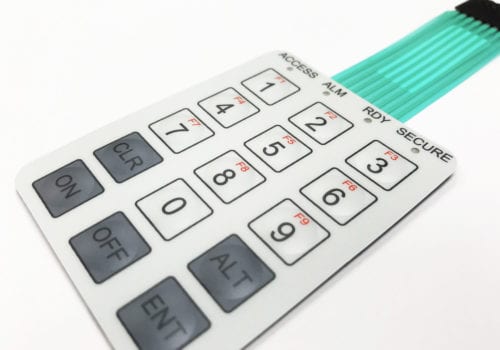Recognizing Membrane Switches Over: The Trick to Trustworthy and durable Controls

What Are Membrane Layer Switches?
Membrane switches are an innovative remedy in the realm of user interface modern technology, combining functionality and design perfectly. These gadgets act as an interface between customers and digital systems, incorporating numerous parts into a small style. Normally created from adaptable, thin layers of products, membrane layer buttons are created to react to touch, making it possible for customers to engage with equipment and digital gadgets successfully.
The key elements of a membrane switch include a printed circuit layer, visuals overlay, and a spacer layer that protects against unplanned activation. The visuals overlay can be tailored to mirror brand name identity or user choices, boosting aesthetic appeals while making sure functionality. Membrane buttons are generally used in different applications, including medical tools, customer electronics, and industrial tools, owing to their toughness and resistance to environmental elements such as dampness and dust.
Among the vital benefits of membrane buttons is their capability to endure wear and tear, making them excellent for high-traffic environments. Additionally, they are light-weight and need minimal room, enabling cutting-edge styles in product growth. In general, membrane layer changes represent a sensible and effective choice for contemporary electronic user interfaces, weding technology with user-centric style principles.
Exactly How Membrane Layer Changes Job
The procedure of membrane switches over depend upon a straightforward yet effective system that translates user input right into electronic signals. These buttons are composed of several layers, typically consisting of a visuals overlay, a spacer layer, and a circuit layer. When a user presses the button, the leading layer flaws, enabling a conductive element in the circuit layer to make contact with an equivalent conductive pad on the bottom of the graphic overlay. This contact closes the circuit and sends out a digital signal to the device, suggesting that the button has been turned on.
The design of membrane buttons can differ, yet they often integrate domes or responsive elements to supply comments to the individual, boosting the total experience - membrane switch. The materials used in membrane switches, such as polyester or polycarbonate, add to their longevity and resistance to environmental factors, including moisture and dust. Additionally, the printed circuits are commonly encapsulated, which secures them from damage with time.
Advantages of Membrane Layer Buttons

In addition, membrane layer buttons are understood for their durability. Constructed from robust materials, they are resistant to dust, moisture, and physical wear, which considerably extends their lifespan compared to traditional mechanical switches. This durability makes them particularly ideal for high-traffic settings and applications calling for long life.
An additional substantial advantage is the simplicity of cleaning and upkeep. The smooth surface area of membrane layer changes reduces dust accumulation and is often unsusceptible spills, making them suitable for setups that need frequent sanitization.
Moreover, membrane layer buttons offer a streamlined account, causing a thinner style that can be integrated right into numerous gadgets without including bulk. This feature not just improves the aesthetic allure however additionally adds to a more ergonomic item style.
Applications of Membrane Buttons
User-friendly and versatile, membrane buttons find applications across a large range of sectors, consisting of medical tools, consumer electronic devices, and industrial devices. In the medical field, these buttons are important to devices such as analysis devices, person tracking systems, and mixture pumps, where dependability and convenience of cleaning are crucial. Their capacity to preserve and endure harsh atmospheres capability makes them suitable for such applications.

In consumer electronic devices, membrane layer switches are made use of in items like microwaves, washing makers, and remote controls - membrane switch. Their sleek style enables for intuitive individual interfaces, boosting the total user experience while supplying durability and resistance to tear and use
Commercial tools also gains from this membrane switches, especially in control panels for equipment and automation systems. These switches provide protection against dirt and wetness, making certain consistent performance in challenging atmospheres. In addition, their customizable functions permit manufacturers to tailor them to specific operational needs, improving performance and capability.
Picking the Right Membrane Switch Over
When picking a membrane layer button, it is important to take into consideration numerous variables that influence performance and viability for details applications. The key factors to consider include environmental conditions, responsive responses, durability, and layout requirements.
First, examine the operating atmosphere; switches revealed to dampness, chemicals, or severe temperatures require specific products to guarantee longevity and functionality. Next off, assess the demand for responsive comments. Depending on customer communication, some applications may gain from a responsive reaction to confirm activation, while others might choose a non-tactile style for aesthetic factors.
Toughness is one more critical aspect; membrane switches need to be developed to withstand constant use, effects, and abrasion. Guarantee additional info the picked button can withstand the anticipated lifecycle, especially in high-usage circumstances.

Verdict
In conclusion, membrane changes offer as essential elements in the layout of dependable and long lasting control systems throughout various markets. The versatility of membrane switches over permits for tailored services that satisfy details operational needs, enhancing their significance in modern-day innovation.
Membrane layer switches stand for a critical facet of modern read the full info here interface layout, blending functionality with durability in various applications.Membrane layer switches are a sophisticated option in the realm of user interface innovation, integrating performance and layout perfectly. Normally built from adaptable, thin layers of products, membrane buttons are created to react to touch, enabling customers to communicate with equipment and digital tools successfully.
The layout of membrane layer buttons can differ, yet they typically incorporate domes or tactile components to give responses to the individual, improving the overall experience.In final thought, membrane changes offer as vital elements in the style of dependable and durable control systems across numerous industries.